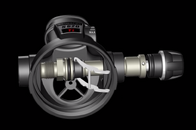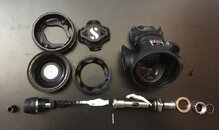Somewhat unrelated but still on topic of these regs:
One thing I have been wondering about whether the balance chamber in a end-barrel-balanced reg can act as a "servo valve" when combined with balanced piston regs. I mean when the IP drops before the piston moves and opens, does the pressure in the balance chamber react quickly enough to reduce pressure on the poppet and allow further poppet separation?
I mean, sure, the whole point of balancing is that opening force is constant through IP range. But can a quick drop of IP followed by quick recovery and huge flow achieve a quick drop in IP of the balance chamber, and then allow the recovery wave of high IP air to flow past the poppet before re-establishing IP in the balance chamber (and is this more pronounced in the G500)?
If so, then then the initial IP drop we seem to be observing just before a balanced piston 1st stage fully opens, might work to achieve an extra boost of air.





